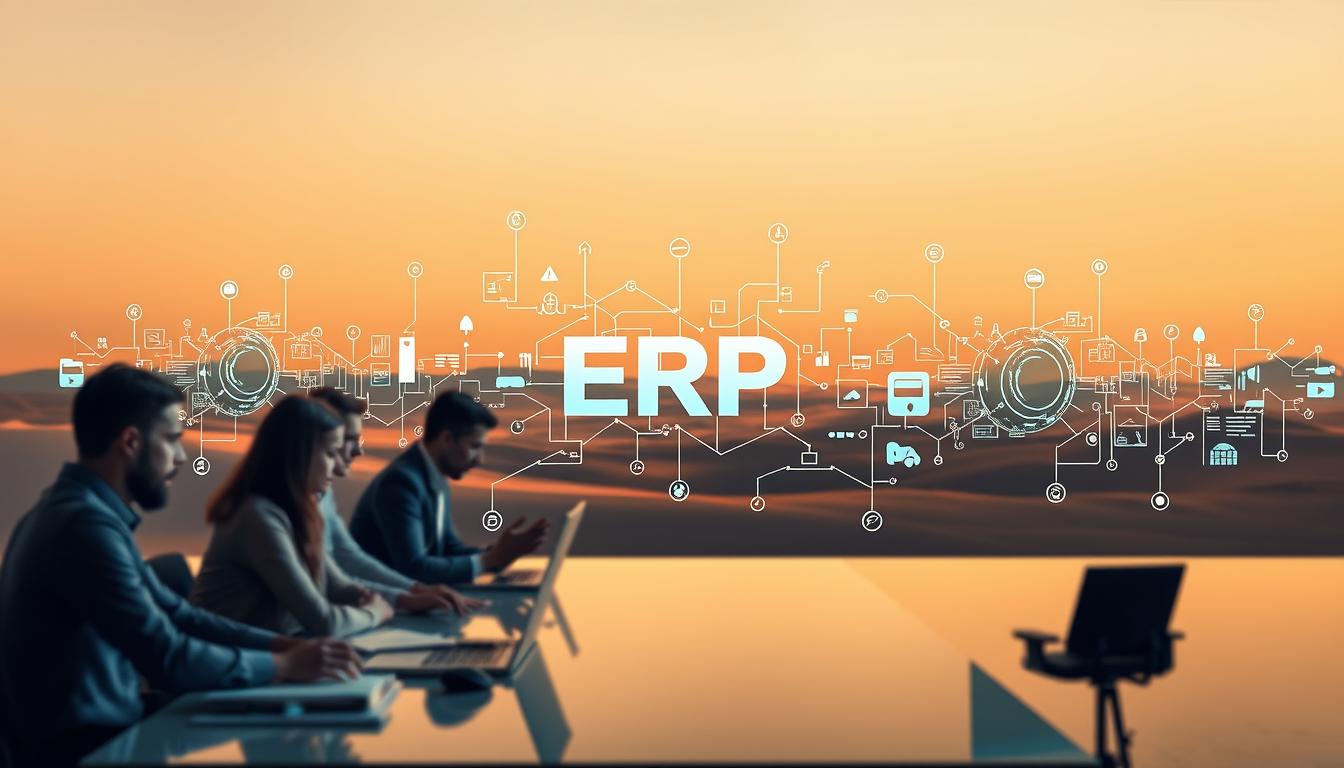Are you ready to make your operations smoother but don’t know how to link your new ERP system with other tools? Integrating an ERP system is key to boosting efficiency and staying ahead, crucial for small and medium businesses in the Philippines. We’ll explore ERP integration, its importance, common challenges, and solutions for better data migration & integration. Let’s start this journey to a unified operational space.
Key Takeaways
- Understanding the importance of ERP integration for operational efficiency.
- Assessing your business needs to choose the right tools for integration.
- Identifying common challenges in data migration & integration.
- Implementing best practices for data integrity and quality.
- Learning from real-world success stories to inform your strategy.
- Establishing a plan for post-integration monitoring and maintenance.
The Importance of ERP Integration
ERP systems are key to smooth information flow in businesses. For small and medium enterprises (SMEs) in the Philippines, they are crucial. They make systems like CRM, inventory management, and financial software talk to each other easily.
This connection cuts down on data silos and manual work. It means fewer errors in data. This leads to more reliable info for making decisions. ERP integration makes operations smoother and improves teamwork.
Companies that use an integrated ERP system see big improvements. They make decisions faster and use resources better. By choosing ERP integration, businesses set themselves up for growth and success in a tough market.
Understanding Your Business Needs
Before you get a new ERP system, you need to check your business processes. It’s important to look at each department’s roles and needs. Talking to department heads helps you find out what each area needs and the challenges they face.
Sales teams might need good reporting tools to track their performance. Inventory management might want better data access for up-to-date stock info. Meeting these needs helps make your operations smoother and more efficient.
Focus on key areas like:
- Inventory management
- Sales tracking
- Customer service functionalities
For small and medium businesses in the Philippines, knowing the local market and customer behavior is key. This helps choose the right ERP for your needs. It makes your daily operations better and helps you reach your goals.
| Department | Key Requirement | Impact on Business Processes |
|---|---|---|
| Sales | Enhanced Reporting Tools | Improved sales strategy management |
| Inventory | Real-Time Data Access | Reduction in stock discrepancies |
| Customer Service | Integrated Communication Platforms | Increased customer satisfaction |
Choosing the Right ERP Integration Method
Choosing the right ERP integration method is key for a smooth system setup. Among the many ERP integration methods, Point-to-Point (P2P) connections are simple and effective for small businesses. They connect apps directly but can get complex as needs grow.
For bigger needs, Integration Platform as a Service (iPaaS) and Platform as a Service (PaaS) are better. They manage many systems at once. This makes them great for growing businesses in the Philippines, like retail and service.
Think about your current setup and future plans to pick the best integration method. This choice affects your success and productivity in the long run.
Common Challenges in Data Migration & Integration
Switching to a new ERP system brings many challenges. Data migration is a big one, as it deals with different data formats from old systems. Companies often face issues with data compatibility, leading to mistakes during the transfer.
To overcome these problems, businesses must carefully check their data. This ensures a smooth move to the new system.
Data Compatibility Issues
Matching data formats is a big challenge in data migration. Different structures can cause problems, like missing or wrong information. This makes integration hard.
Companies need to spend time understanding their data. They should make sure all data is in the same format. This makes transfers easier and cuts down on mistakes.
Operational Continuity Risks
Switching to a new ERP system can disrupt daily work. Without proper planning, it can lead to downtime. This hurts productivity and efficiency.
To avoid these problems, businesses should plan carefully. They should have backup plans and train their staff. This helps keep operations running smoothly while teams learn the new system.
For a detailed solution, companies can look into tools that improve integration.
Solutions for Seamless Integration
Getting ERP systems to work together smoothly requires careful planning. Companies need a detailed project plan. This plan should list tasks, who’s doing them, when, and what’s needed. This way, they can make changes quickly to improve how things work together.
Strategic Planning Steps
Here are key steps for planning integration:
- Check what systems and processes you have to see what needs to be connected.
- Set clear goals for what you want to achieve with the ERP system.
- Make a timeline with key dates to track your progress.
- Make sure you have all the tools and people you need.
Utilizing Integration Tools
Integration tools are crucial for linking ERP systems with other apps. Tools like Acumatica make these connections easier, cutting down on manual work. For Filipino SMEs, using these tools can help meet their goals and save time.
By using these tools, businesses can focus on their main tasks. They can also make their workflows more efficient. For more on digital transformation benefits, check out this link.
Best Practices for Data Integrity and Quality
Keeping data clean and accurate is key during ERP integration. Companies must have strong plans to handle their data well. This ensures a smooth transition without losing important info. Here are some top practices for better data validation and ongoing quality control.
Data Validation Tactics
It’s vital to use strict data validation tactics to keep data reliable. This means checking data often for its accuracy and consistency. Some good ways to do this include:
- Using automated tools to find and fix errors.
- Creating rules for data based on specific criteria, like format and value.
- Doing regular data audits to catch any mistakes missed before.
Automating Data Entry
Automating data entry helps cut down on mistakes and boosts quality. The advantages of automation are:
- It makes work faster by reducing manual entry time.
- It lowers errors with set inputs and checks.
- It lets teams focus on important tasks, not just data entry.
Having clear data rules is also important. These rules help with following rules and make better decisions. Good data means a better understanding of business, customers, and markets, which is crucial for businesses in the Philippines.
Real-World Success Stories
Many small and medium enterprises (SMEs) in the Philippines have seen big changes with ERP. These ERP success stories show how well ERP can change a business. For example, Tien Phong Plastic in Vietnam got better with Acumatica Cloud ERP. They now work more efficiently, showing a big business transformation.
In the Philippines, some companies have also adopted ERP systems. They’ve seen big improvements in managing inventory and dealing with customers. These changes have made their operations more efficient and cut costs. This proves the benefits of using ERP well. The many case studies out there inspire other SMEs to improve their businesses.
| Company | ERP System | Improvement Achieved | Highlights |
|---|---|---|---|
| Tien Phong Plastic | Acumatica Cloud ERP | Operational Efficiency | Streamlined processes, reduced errors |
| SME A | SAP Business One | Inventory Management | Real-time tracking, cost reductions |
| SME B | Oracle NetSuite | Customer Relationship Management | Improved customer satisfaction and sales |
Monitoring and Maintenance Post-Integration
After integrating an ERP system, it’s key to keep an eye on its performance. Companies should use real-time tracking to watch data closely. This helps spot problems early, stopping small issues from becoming big ones.
Regular audits and system checks are vital for upkeep. These reviews find areas that need work, keeping the ERP system up to date. Regular care keeps things running smoothly and gets businesses ready for future changes.
For small to medium businesses in the Philippines, keeping the ERP system in top shape is crucial. Being ready for changes helps companies meet new needs quickly. This proactive approach is key to success.
| Maintenance Activity | Frequency | Purpose |
|---|---|---|
| Real-time Monitoring | Continuous | Identify data discrepancies promptly |
| System Audits | Quarterly | Assess overall system health |
| Performance Evaluations | Biannual | Gauge ERP performance against business goals |
| Software Updates | As recommended | Incorporate new features and security improvements |
Conclusion
ERP integration is key for SMEs in the Philippines to grow and work better. It helps them understand their needs and pick the right way to integrate. This makes their work more efficient and effective.
Keeping data accurate is very important. It makes sure the information is right and trustworthy. Also, staying up-to-date with new tools helps keep ERP systems working well for the business.
Using ERP integration helps companies deal with market challenges. It lets them find new chances and succeed in a tough market.




